Analysis of Total Quality Management System at Vodafone, UK: A Report
VerifiedAdded on 2021/04/17
|15
|3475
|21
Report
AI Summary
This report provides a comprehensive analysis of Vodafone's Total Quality Management (TQM) system in the UK. It begins with an introduction to quality management and its importance, followed by a background on Vodafone. The report evaluates Vodafone's quality management system, discussing TQM principles, including Deming's theory, and the application of ISO standards (ISO 9001 and ISO 20000). It examines the service management policies and objectives for Information Security Management (ISMS) within Vodafone. The report then delves into the implementation methods used, such as organization model approach and award criteria approach, along with the challenges encountered, including poor planning, lack of managerial commitment, inadequate training, and insufficient resources. Finally, the report outlines how Vodafone mitigated these difficulties to improve its quality management system, and concludes with a summary of key findings and recommendations.
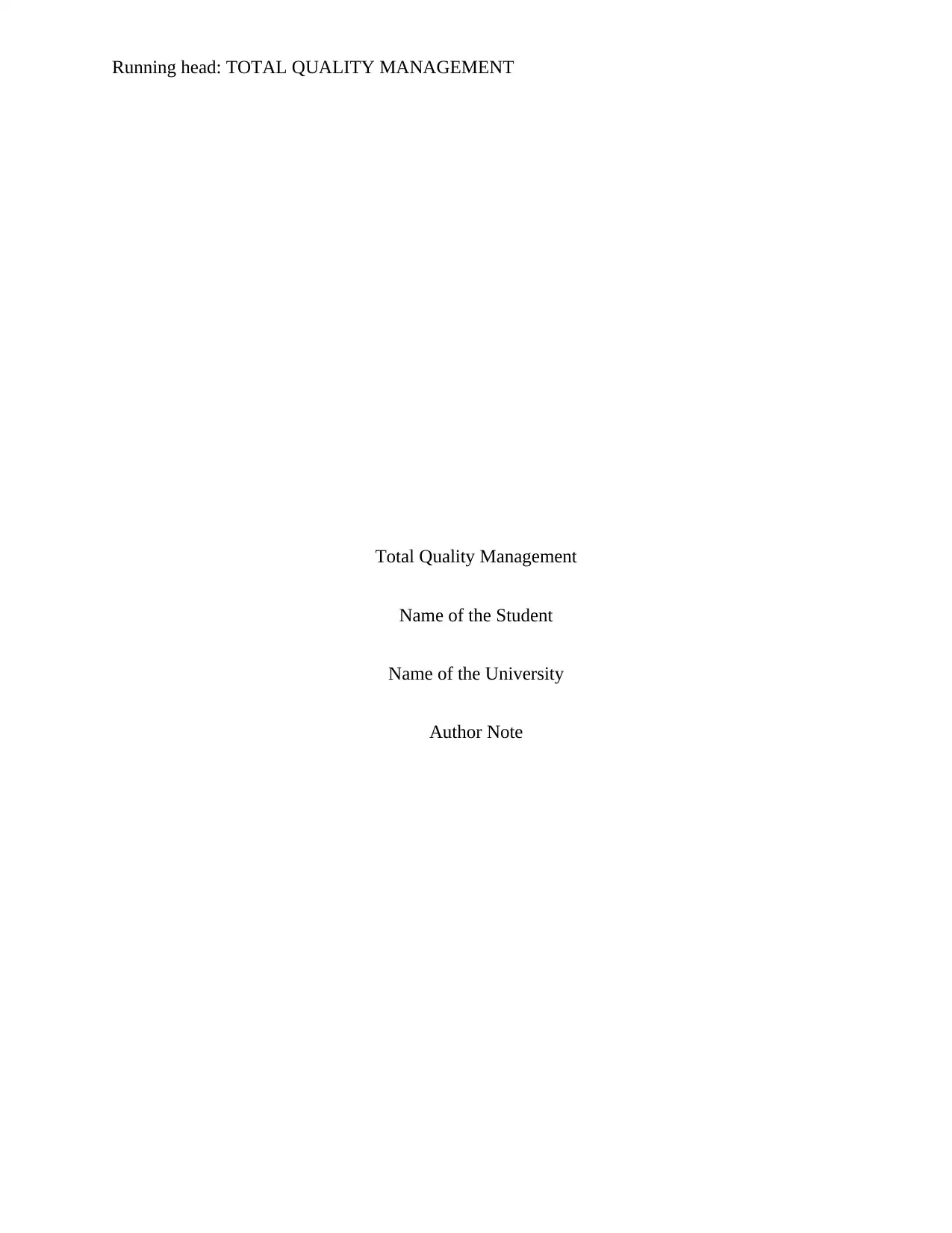
Running head: TOTAL QUALITY MANAGEMENT
Total Quality Management
Name of the Student
Name of the University
Author Note
Total Quality Management
Name of the Student
Name of the University
Author Note
Paraphrase This Document
Need a fresh take? Get an instant paraphrase of this document with our AI Paraphraser
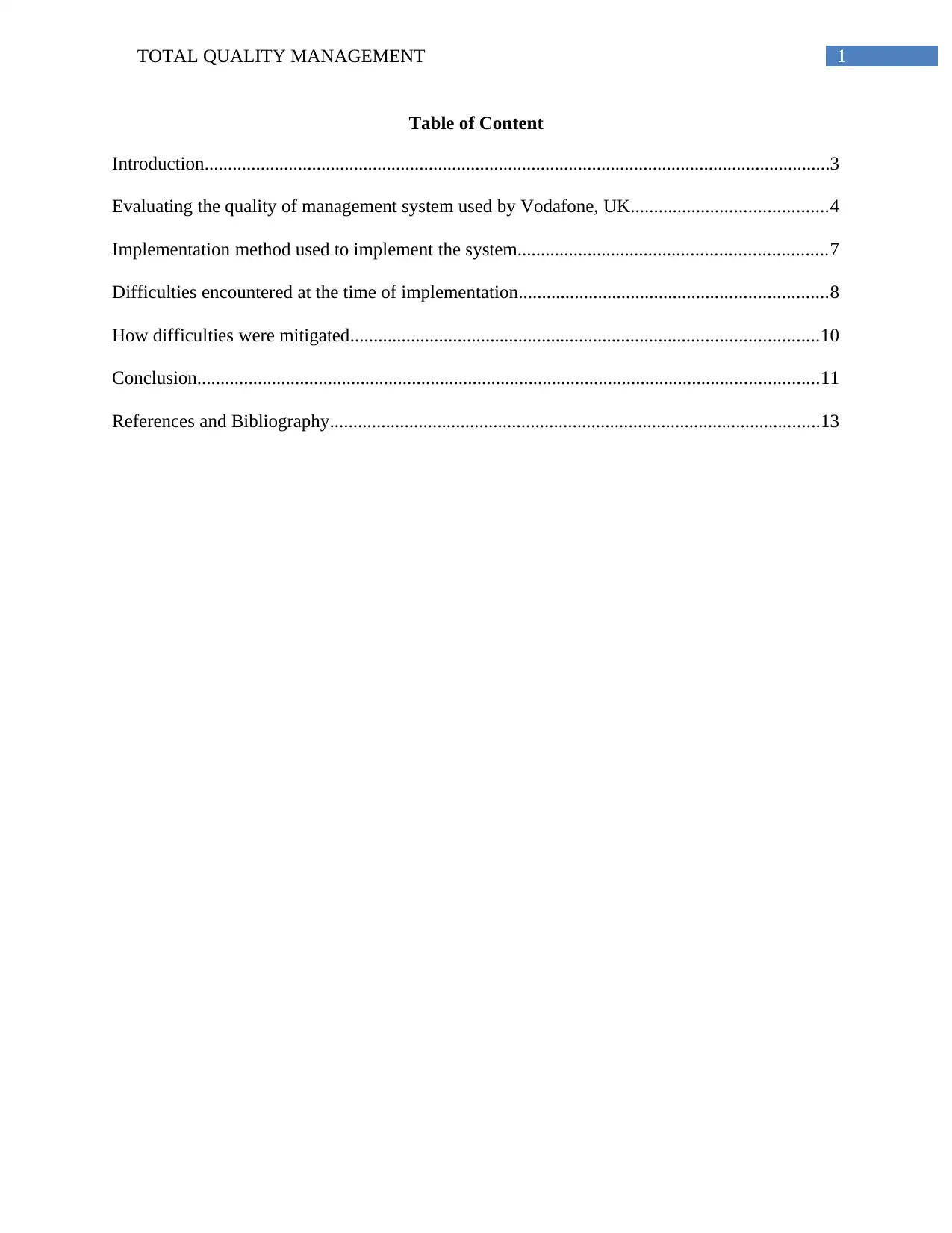
1TOTAL QUALITY MANAGEMENT
Table of Content
Introduction......................................................................................................................................3
Evaluating the quality of management system used by Vodafone, UK..........................................4
Implementation method used to implement the system..................................................................7
Difficulties encountered at the time of implementation..................................................................8
How difficulties were mitigated....................................................................................................10
Conclusion.....................................................................................................................................11
References and Bibliography.........................................................................................................13
Table of Content
Introduction......................................................................................................................................3
Evaluating the quality of management system used by Vodafone, UK..........................................4
Implementation method used to implement the system..................................................................7
Difficulties encountered at the time of implementation..................................................................8
How difficulties were mitigated....................................................................................................10
Conclusion.....................................................................................................................................11
References and Bibliography.........................................................................................................13
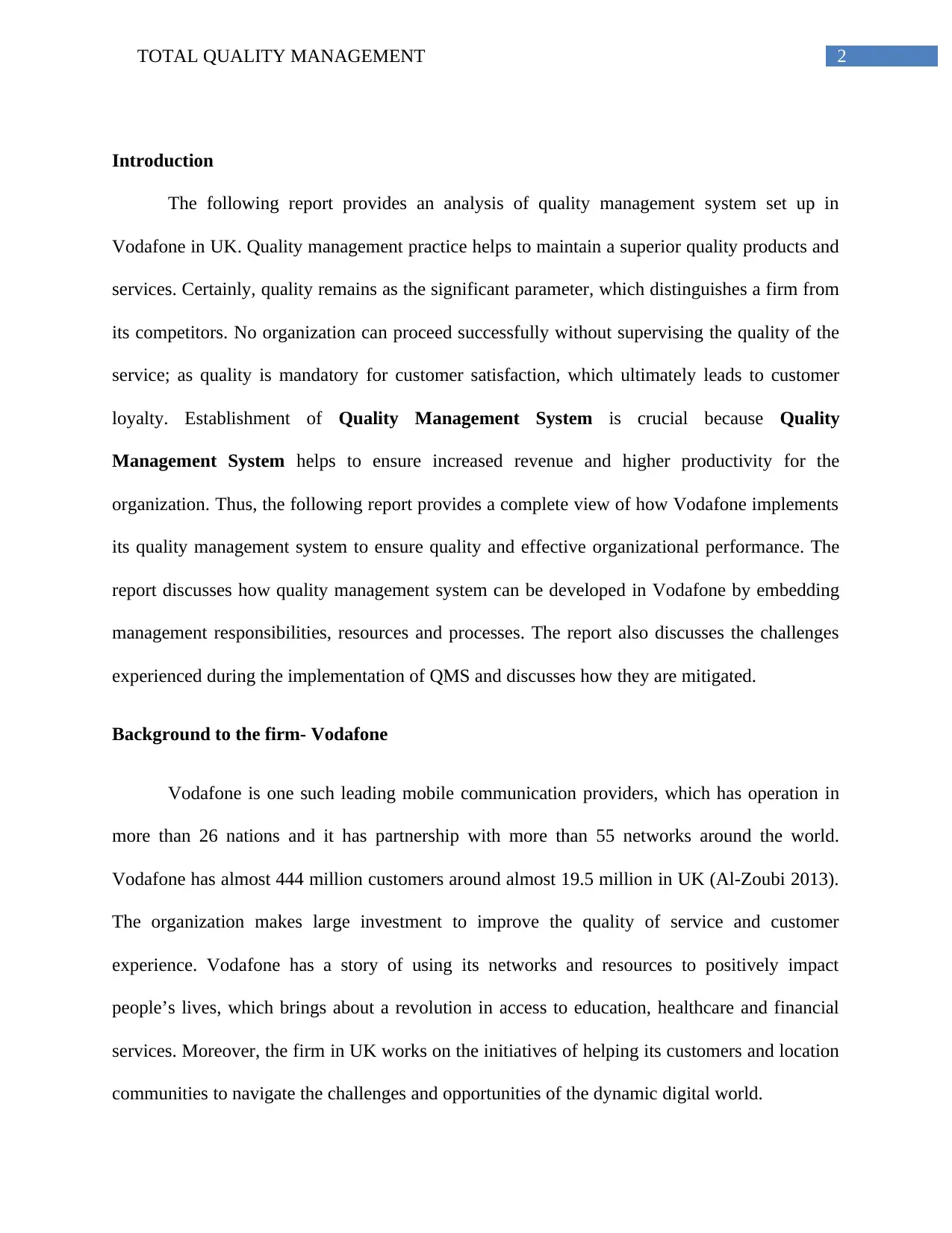
2TOTAL QUALITY MANAGEMENT
Introduction
The following report provides an analysis of quality management system set up in
Vodafone in UK. Quality management practice helps to maintain a superior quality products and
services. Certainly, quality remains as the significant parameter, which distinguishes a firm from
its competitors. No organization can proceed successfully without supervising the quality of the
service; as quality is mandatory for customer satisfaction, which ultimately leads to customer
loyalty. Establishment of Quality Management System is crucial because Quality
Management System helps to ensure increased revenue and higher productivity for the
organization. Thus, the following report provides a complete view of how Vodafone implements
its quality management system to ensure quality and effective organizational performance. The
report discusses how quality management system can be developed in Vodafone by embedding
management responsibilities, resources and processes. The report also discusses the challenges
experienced during the implementation of QMS and discusses how they are mitigated.
Background to the firm- Vodafone
Vodafone is one such leading mobile communication providers, which has operation in
more than 26 nations and it has partnership with more than 55 networks around the world.
Vodafone has almost 444 million customers around almost 19.5 million in UK (Al-Zoubi 2013).
The organization makes large investment to improve the quality of service and customer
experience. Vodafone has a story of using its networks and resources to positively impact
people’s lives, which brings about a revolution in access to education, healthcare and financial
services. Moreover, the firm in UK works on the initiatives of helping its customers and location
communities to navigate the challenges and opportunities of the dynamic digital world.
Introduction
The following report provides an analysis of quality management system set up in
Vodafone in UK. Quality management practice helps to maintain a superior quality products and
services. Certainly, quality remains as the significant parameter, which distinguishes a firm from
its competitors. No organization can proceed successfully without supervising the quality of the
service; as quality is mandatory for customer satisfaction, which ultimately leads to customer
loyalty. Establishment of Quality Management System is crucial because Quality
Management System helps to ensure increased revenue and higher productivity for the
organization. Thus, the following report provides a complete view of how Vodafone implements
its quality management system to ensure quality and effective organizational performance. The
report discusses how quality management system can be developed in Vodafone by embedding
management responsibilities, resources and processes. The report also discusses the challenges
experienced during the implementation of QMS and discusses how they are mitigated.
Background to the firm- Vodafone
Vodafone is one such leading mobile communication providers, which has operation in
more than 26 nations and it has partnership with more than 55 networks around the world.
Vodafone has almost 444 million customers around almost 19.5 million in UK (Al-Zoubi 2013).
The organization makes large investment to improve the quality of service and customer
experience. Vodafone has a story of using its networks and resources to positively impact
people’s lives, which brings about a revolution in access to education, healthcare and financial
services. Moreover, the firm in UK works on the initiatives of helping its customers and location
communities to navigate the challenges and opportunities of the dynamic digital world.
⊘ This is a preview!⊘
Do you want full access?
Subscribe today to unlock all pages.

Trusted by 1+ million students worldwide
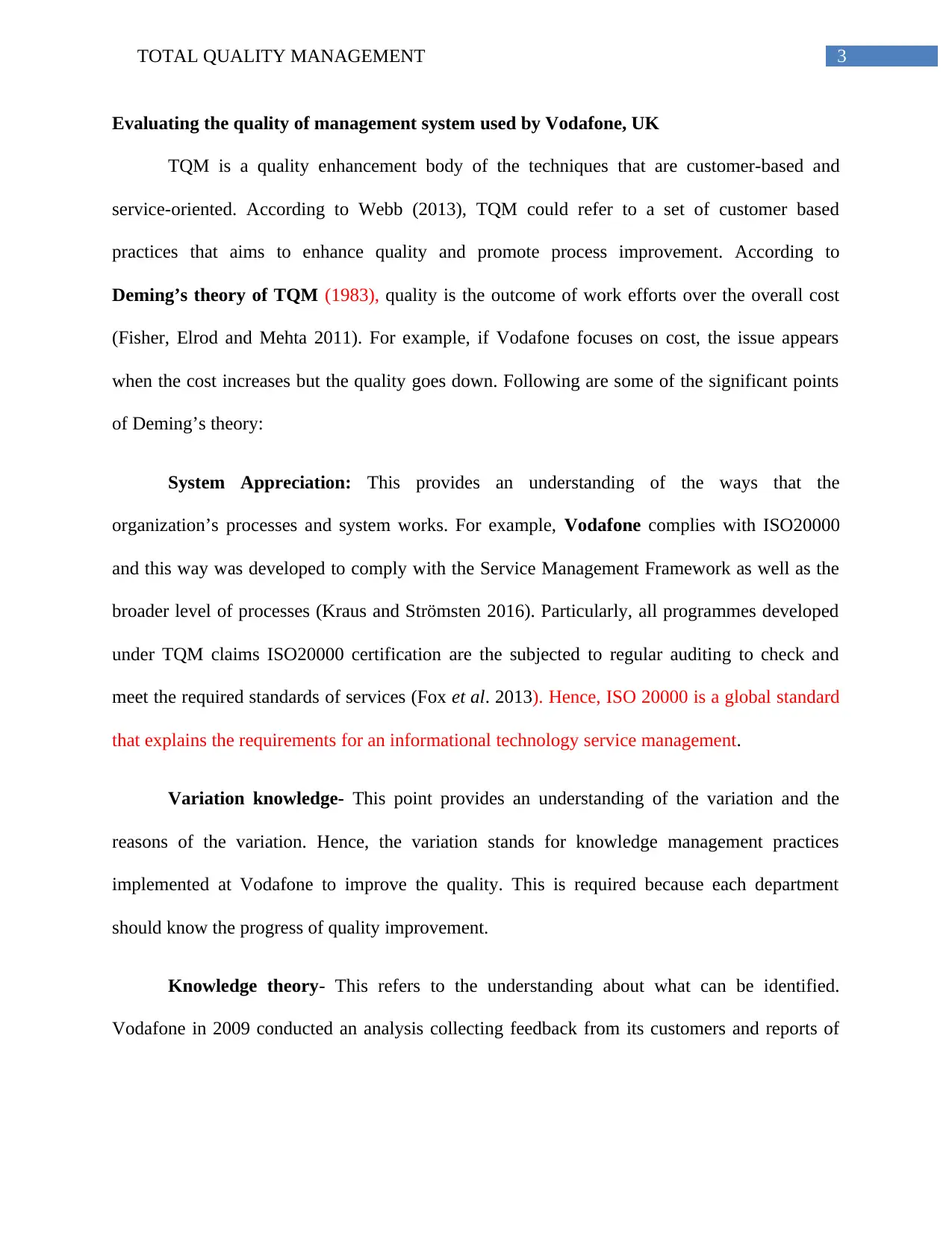
3TOTAL QUALITY MANAGEMENT
Evaluating the quality of management system used by Vodafone, UK
TQM is a quality enhancement body of the techniques that are customer-based and
service-oriented. According to Webb (2013), TQM could refer to a set of customer based
practices that aims to enhance quality and promote process improvement. According to
Deming’s theory of TQM (1983), quality is the outcome of work efforts over the overall cost
(Fisher, Elrod and Mehta 2011). For example, if Vodafone focuses on cost, the issue appears
when the cost increases but the quality goes down. Following are some of the significant points
of Deming’s theory:
System Appreciation: This provides an understanding of the ways that the
organization’s processes and system works. For example, Vodafone complies with ISO20000
and this way was developed to comply with the Service Management Framework as well as the
broader level of processes (Kraus and Strömsten 2016). Particularly, all programmes developed
under TQM claims ISO20000 certification are the subjected to regular auditing to check and
meet the required standards of services (Fox et al. 2013). Hence, ISO 20000 is a global standard
that explains the requirements for an informational technology service management.
Variation knowledge- This point provides an understanding of the variation and the
reasons of the variation. Hence, the variation stands for knowledge management practices
implemented at Vodafone to improve the quality. This is required because each department
should know the progress of quality improvement.
Knowledge theory- This refers to the understanding about what can be identified.
Vodafone in 2009 conducted an analysis collecting feedback from its customers and reports of
Evaluating the quality of management system used by Vodafone, UK
TQM is a quality enhancement body of the techniques that are customer-based and
service-oriented. According to Webb (2013), TQM could refer to a set of customer based
practices that aims to enhance quality and promote process improvement. According to
Deming’s theory of TQM (1983), quality is the outcome of work efforts over the overall cost
(Fisher, Elrod and Mehta 2011). For example, if Vodafone focuses on cost, the issue appears
when the cost increases but the quality goes down. Following are some of the significant points
of Deming’s theory:
System Appreciation: This provides an understanding of the ways that the
organization’s processes and system works. For example, Vodafone complies with ISO20000
and this way was developed to comply with the Service Management Framework as well as the
broader level of processes (Kraus and Strömsten 2016). Particularly, all programmes developed
under TQM claims ISO20000 certification are the subjected to regular auditing to check and
meet the required standards of services (Fox et al. 2013). Hence, ISO 20000 is a global standard
that explains the requirements for an informational technology service management.
Variation knowledge- This point provides an understanding of the variation and the
reasons of the variation. Hence, the variation stands for knowledge management practices
implemented at Vodafone to improve the quality. This is required because each department
should know the progress of quality improvement.
Knowledge theory- This refers to the understanding about what can be identified.
Vodafone in 2009 conducted an analysis collecting feedback from its customers and reports of
Paraphrase This Document
Need a fresh take? Get an instant paraphrase of this document with our AI Paraphraser
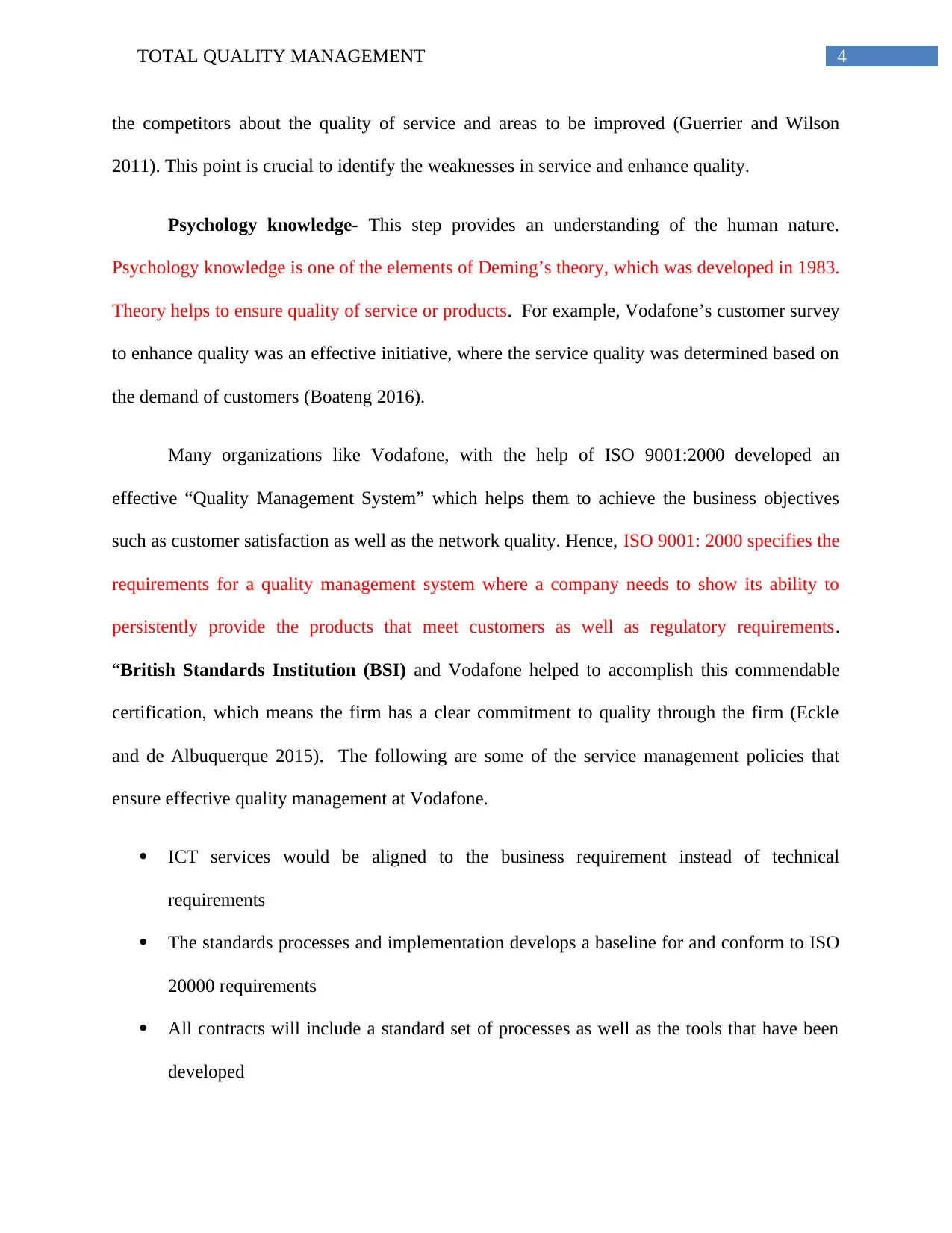
4TOTAL QUALITY MANAGEMENT
the competitors about the quality of service and areas to be improved (Guerrier and Wilson
2011). This point is crucial to identify the weaknesses in service and enhance quality.
Psychology knowledge- This step provides an understanding of the human nature.
Psychology knowledge is one of the elements of Deming’s theory, which was developed in 1983.
Theory helps to ensure quality of service or products. For example, Vodafone’s customer survey
to enhance quality was an effective initiative, where the service quality was determined based on
the demand of customers (Boateng 2016).
Many organizations like Vodafone, with the help of ISO 9001:2000 developed an
effective “Quality Management System” which helps them to achieve the business objectives
such as customer satisfaction as well as the network quality. Hence, ISO 9001: 2000 specifies the
requirements for a quality management system where a company needs to show its ability to
persistently provide the products that meet customers as well as regulatory requirements.
“British Standards Institution (BSI) and Vodafone helped to accomplish this commendable
certification, which means the firm has a clear commitment to quality through the firm (Eckle
and de Albuquerque 2015). The following are some of the service management policies that
ensure effective quality management at Vodafone.
ICT services would be aligned to the business requirement instead of technical
requirements
The standards processes and implementation develops a baseline for and conform to ISO
20000 requirements
All contracts will include a standard set of processes as well as the tools that have been
developed
the competitors about the quality of service and areas to be improved (Guerrier and Wilson
2011). This point is crucial to identify the weaknesses in service and enhance quality.
Psychology knowledge- This step provides an understanding of the human nature.
Psychology knowledge is one of the elements of Deming’s theory, which was developed in 1983.
Theory helps to ensure quality of service or products. For example, Vodafone’s customer survey
to enhance quality was an effective initiative, where the service quality was determined based on
the demand of customers (Boateng 2016).
Many organizations like Vodafone, with the help of ISO 9001:2000 developed an
effective “Quality Management System” which helps them to achieve the business objectives
such as customer satisfaction as well as the network quality. Hence, ISO 9001: 2000 specifies the
requirements for a quality management system where a company needs to show its ability to
persistently provide the products that meet customers as well as regulatory requirements.
“British Standards Institution (BSI) and Vodafone helped to accomplish this commendable
certification, which means the firm has a clear commitment to quality through the firm (Eckle
and de Albuquerque 2015). The following are some of the service management policies that
ensure effective quality management at Vodafone.
ICT services would be aligned to the business requirement instead of technical
requirements
The standards processes and implementation develops a baseline for and conform to ISO
20000 requirements
All contracts will include a standard set of processes as well as the tools that have been
developed
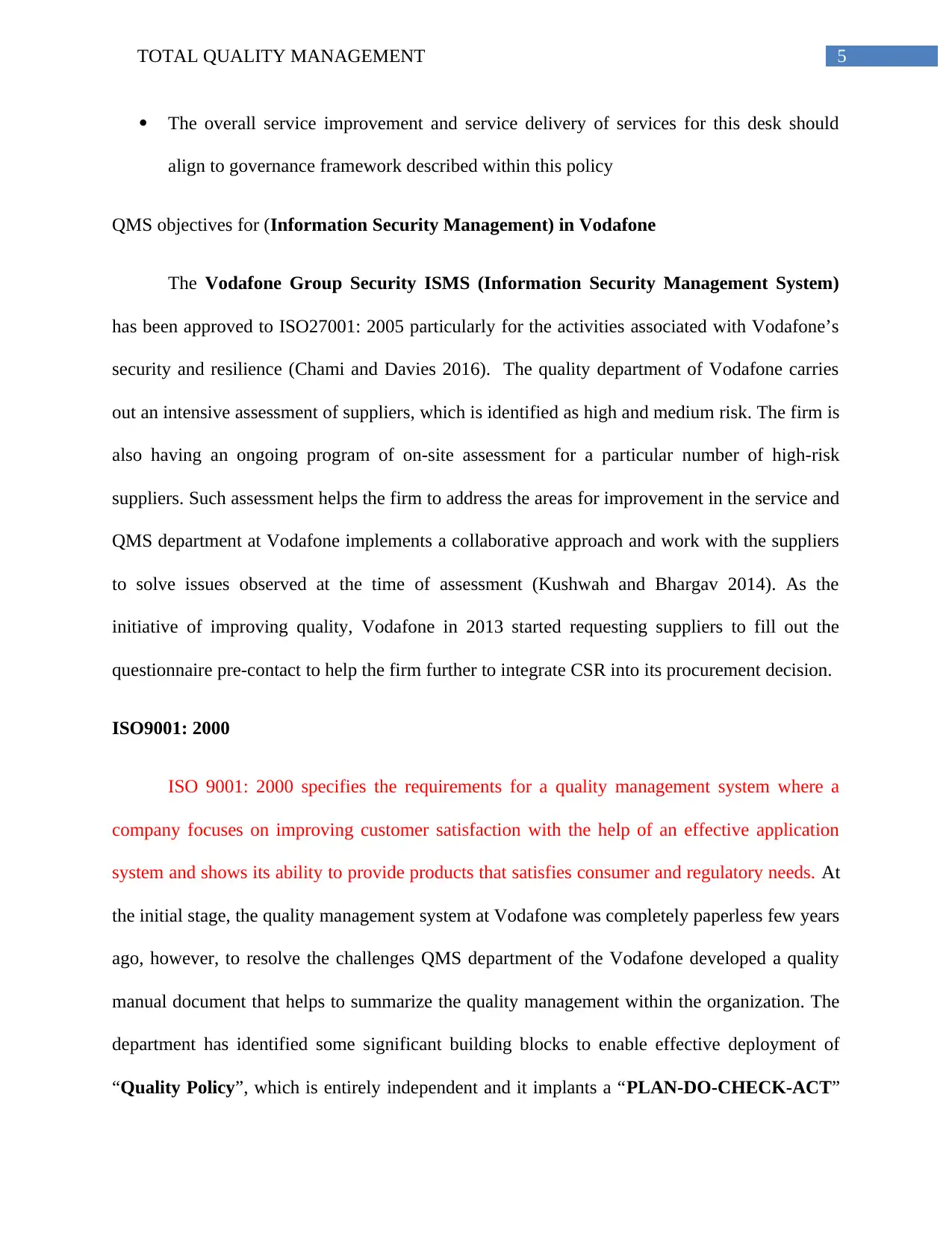
5TOTAL QUALITY MANAGEMENT
The overall service improvement and service delivery of services for this desk should
align to governance framework described within this policy
QMS objectives for (Information Security Management) in Vodafone
The Vodafone Group Security ISMS (Information Security Management System)
has been approved to ISO27001: 2005 particularly for the activities associated with Vodafone’s
security and resilience (Chami and Davies 2016). The quality department of Vodafone carries
out an intensive assessment of suppliers, which is identified as high and medium risk. The firm is
also having an ongoing program of on-site assessment for a particular number of high-risk
suppliers. Such assessment helps the firm to address the areas for improvement in the service and
QMS department at Vodafone implements a collaborative approach and work with the suppliers
to solve issues observed at the time of assessment (Kushwah and Bhargav 2014). As the
initiative of improving quality, Vodafone in 2013 started requesting suppliers to fill out the
questionnaire pre-contact to help the firm further to integrate CSR into its procurement decision.
ISO9001: 2000
ISO 9001: 2000 specifies the requirements for a quality management system where a
company focuses on improving customer satisfaction with the help of an effective application
system and shows its ability to provide products that satisfies consumer and regulatory needs. At
the initial stage, the quality management system at Vodafone was completely paperless few years
ago, however, to resolve the challenges QMS department of the Vodafone developed a quality
manual document that helps to summarize the quality management within the organization. The
department has identified some significant building blocks to enable effective deployment of
“Quality Policy”, which is entirely independent and it implants a “PLAN-DO-CHECK-ACT”
The overall service improvement and service delivery of services for this desk should
align to governance framework described within this policy
QMS objectives for (Information Security Management) in Vodafone
The Vodafone Group Security ISMS (Information Security Management System)
has been approved to ISO27001: 2005 particularly for the activities associated with Vodafone’s
security and resilience (Chami and Davies 2016). The quality department of Vodafone carries
out an intensive assessment of suppliers, which is identified as high and medium risk. The firm is
also having an ongoing program of on-site assessment for a particular number of high-risk
suppliers. Such assessment helps the firm to address the areas for improvement in the service and
QMS department at Vodafone implements a collaborative approach and work with the suppliers
to solve issues observed at the time of assessment (Kushwah and Bhargav 2014). As the
initiative of improving quality, Vodafone in 2013 started requesting suppliers to fill out the
questionnaire pre-contact to help the firm further to integrate CSR into its procurement decision.
ISO9001: 2000
ISO 9001: 2000 specifies the requirements for a quality management system where a
company focuses on improving customer satisfaction with the help of an effective application
system and shows its ability to provide products that satisfies consumer and regulatory needs. At
the initial stage, the quality management system at Vodafone was completely paperless few years
ago, however, to resolve the challenges QMS department of the Vodafone developed a quality
manual document that helps to summarize the quality management within the organization. The
department has identified some significant building blocks to enable effective deployment of
“Quality Policy”, which is entirely independent and it implants a “PLAN-DO-CHECK-ACT”
⊘ This is a preview!⊘
Do you want full access?
Subscribe today to unlock all pages.

Trusted by 1+ million students worldwide
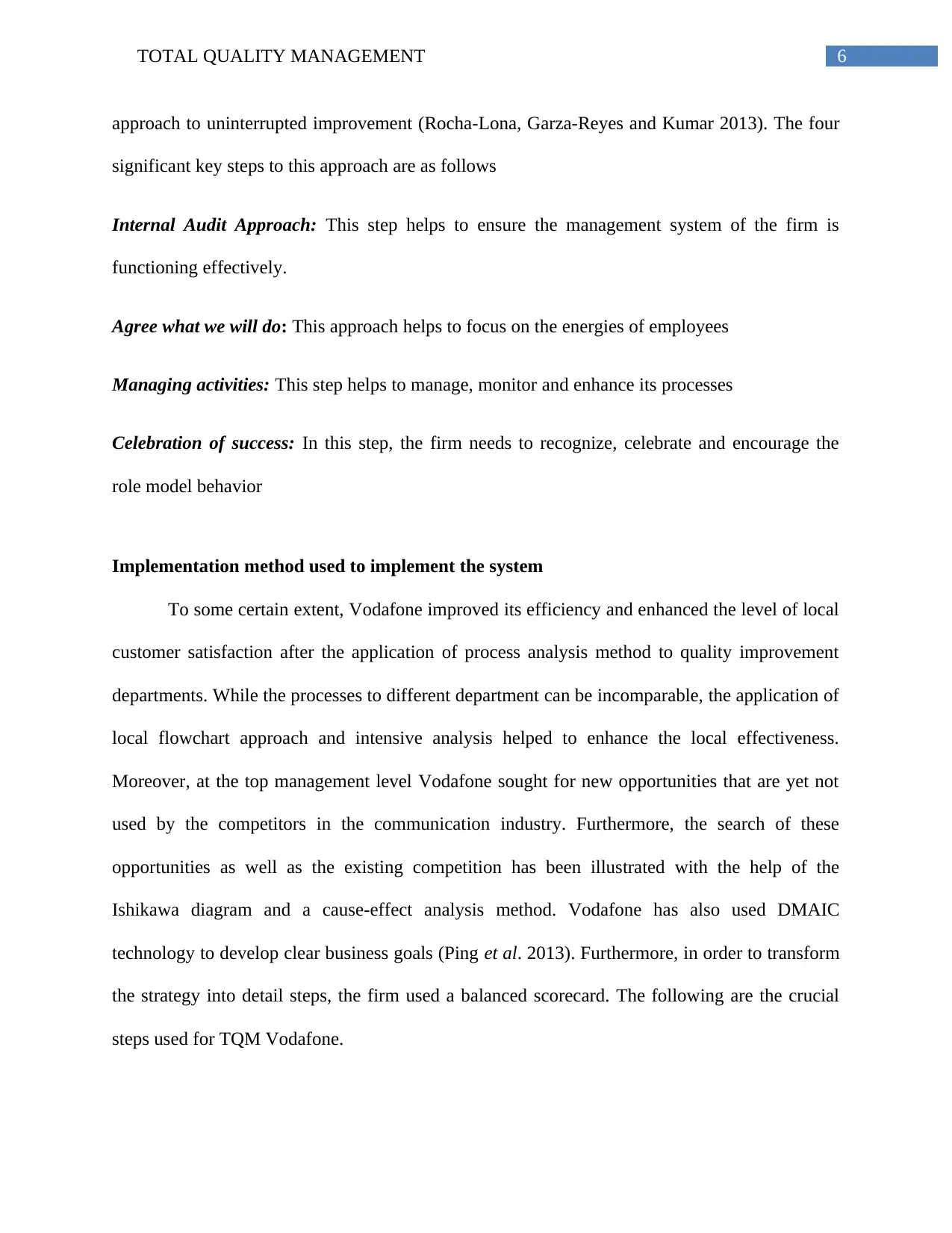
6TOTAL QUALITY MANAGEMENT
approach to uninterrupted improvement (Rocha-Lona, Garza-Reyes and Kumar 2013). The four
significant key steps to this approach are as follows
Internal Audit Approach: This step helps to ensure the management system of the firm is
functioning effectively.
Agree what we will do: This approach helps to focus on the energies of employees
Managing activities: This step helps to manage, monitor and enhance its processes
Celebration of success: In this step, the firm needs to recognize, celebrate and encourage the
role model behavior
Implementation method used to implement the system
To some certain extent, Vodafone improved its efficiency and enhanced the level of local
customer satisfaction after the application of process analysis method to quality improvement
departments. While the processes to different department can be incomparable, the application of
local flowchart approach and intensive analysis helped to enhance the local effectiveness.
Moreover, at the top management level Vodafone sought for new opportunities that are yet not
used by the competitors in the communication industry. Furthermore, the search of these
opportunities as well as the existing competition has been illustrated with the help of the
Ishikawa diagram and a cause-effect analysis method. Vodafone has also used DMAIC
technology to develop clear business goals (Ping et al. 2013). Furthermore, in order to transform
the strategy into detail steps, the firm used a balanced scorecard. The following are the crucial
steps used for TQM Vodafone.
approach to uninterrupted improvement (Rocha-Lona, Garza-Reyes and Kumar 2013). The four
significant key steps to this approach are as follows
Internal Audit Approach: This step helps to ensure the management system of the firm is
functioning effectively.
Agree what we will do: This approach helps to focus on the energies of employees
Managing activities: This step helps to manage, monitor and enhance its processes
Celebration of success: In this step, the firm needs to recognize, celebrate and encourage the
role model behavior
Implementation method used to implement the system
To some certain extent, Vodafone improved its efficiency and enhanced the level of local
customer satisfaction after the application of process analysis method to quality improvement
departments. While the processes to different department can be incomparable, the application of
local flowchart approach and intensive analysis helped to enhance the local effectiveness.
Moreover, at the top management level Vodafone sought for new opportunities that are yet not
used by the competitors in the communication industry. Furthermore, the search of these
opportunities as well as the existing competition has been illustrated with the help of the
Ishikawa diagram and a cause-effect analysis method. Vodafone has also used DMAIC
technology to develop clear business goals (Ping et al. 2013). Furthermore, in order to transform
the strategy into detail steps, the firm used a balanced scorecard. The following are the crucial
steps used for TQM Vodafone.
Paraphrase This Document
Need a fresh take? Get an instant paraphrase of this document with our AI Paraphraser
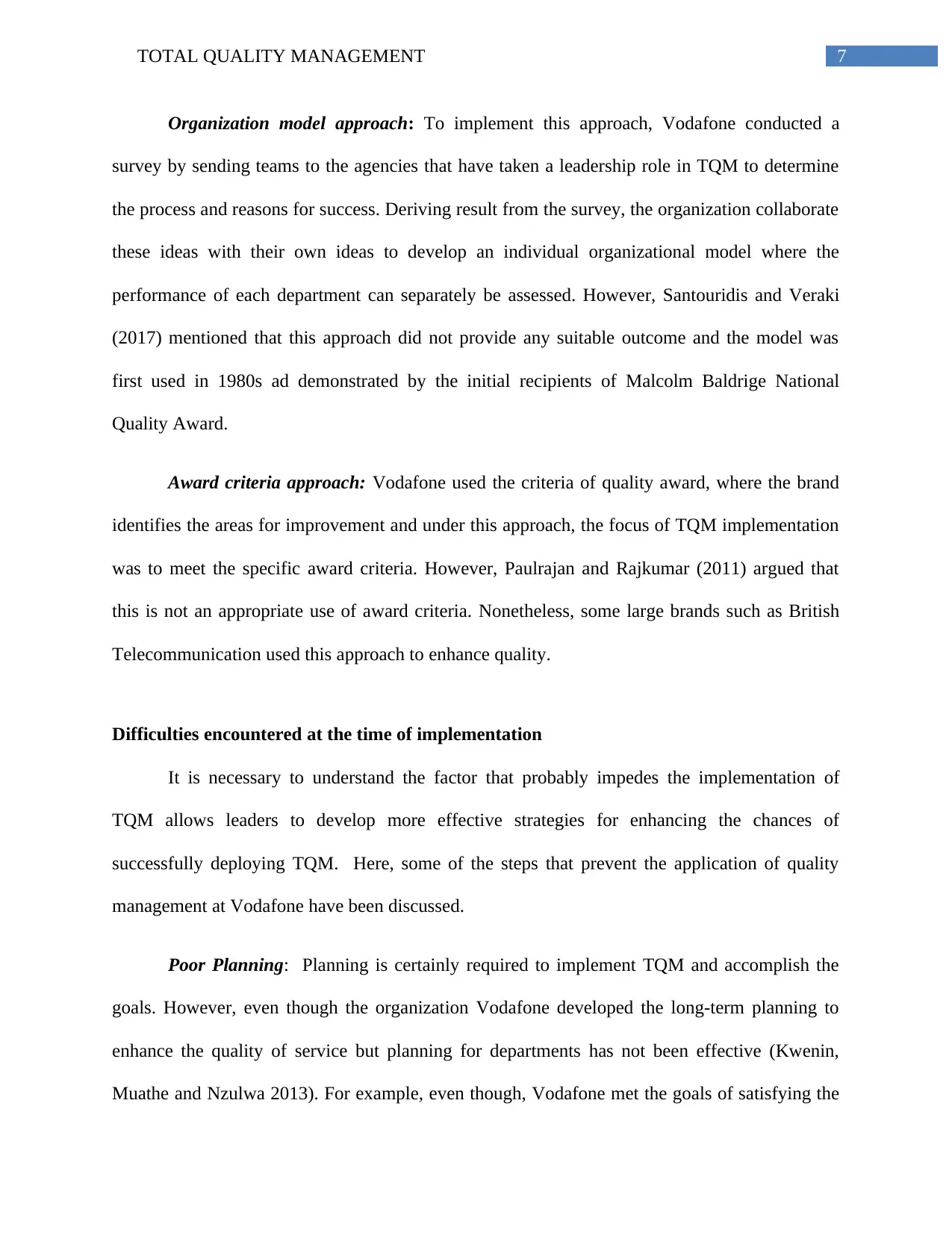
7TOTAL QUALITY MANAGEMENT
Organization model approach: To implement this approach, Vodafone conducted a
survey by sending teams to the agencies that have taken a leadership role in TQM to determine
the process and reasons for success. Deriving result from the survey, the organization collaborate
these ideas with their own ideas to develop an individual organizational model where the
performance of each department can separately be assessed. However, Santouridis and Veraki
(2017) mentioned that this approach did not provide any suitable outcome and the model was
first used in 1980s ad demonstrated by the initial recipients of Malcolm Baldrige National
Quality Award.
Award criteria approach: Vodafone used the criteria of quality award, where the brand
identifies the areas for improvement and under this approach, the focus of TQM implementation
was to meet the specific award criteria. However, Paulrajan and Rajkumar (2011) argued that
this is not an appropriate use of award criteria. Nonetheless, some large brands such as British
Telecommunication used this approach to enhance quality.
Difficulties encountered at the time of implementation
It is necessary to understand the factor that probably impedes the implementation of
TQM allows leaders to develop more effective strategies for enhancing the chances of
successfully deploying TQM. Here, some of the steps that prevent the application of quality
management at Vodafone have been discussed.
Poor Planning: Planning is certainly required to implement TQM and accomplish the
goals. However, even though the organization Vodafone developed the long-term planning to
enhance the quality of service but planning for departments has not been effective (Kwenin,
Muathe and Nzulwa 2013). For example, even though, Vodafone met the goals of satisfying the
Organization model approach: To implement this approach, Vodafone conducted a
survey by sending teams to the agencies that have taken a leadership role in TQM to determine
the process and reasons for success. Deriving result from the survey, the organization collaborate
these ideas with their own ideas to develop an individual organizational model where the
performance of each department can separately be assessed. However, Santouridis and Veraki
(2017) mentioned that this approach did not provide any suitable outcome and the model was
first used in 1980s ad demonstrated by the initial recipients of Malcolm Baldrige National
Quality Award.
Award criteria approach: Vodafone used the criteria of quality award, where the brand
identifies the areas for improvement and under this approach, the focus of TQM implementation
was to meet the specific award criteria. However, Paulrajan and Rajkumar (2011) argued that
this is not an appropriate use of award criteria. Nonetheless, some large brands such as British
Telecommunication used this approach to enhance quality.
Difficulties encountered at the time of implementation
It is necessary to understand the factor that probably impedes the implementation of
TQM allows leaders to develop more effective strategies for enhancing the chances of
successfully deploying TQM. Here, some of the steps that prevent the application of quality
management at Vodafone have been discussed.
Poor Planning: Planning is certainly required to implement TQM and accomplish the
goals. However, even though the organization Vodafone developed the long-term planning to
enhance the quality of service but planning for departments has not been effective (Kwenin,
Muathe and Nzulwa 2013). For example, even though, Vodafone met the goals of satisfying the
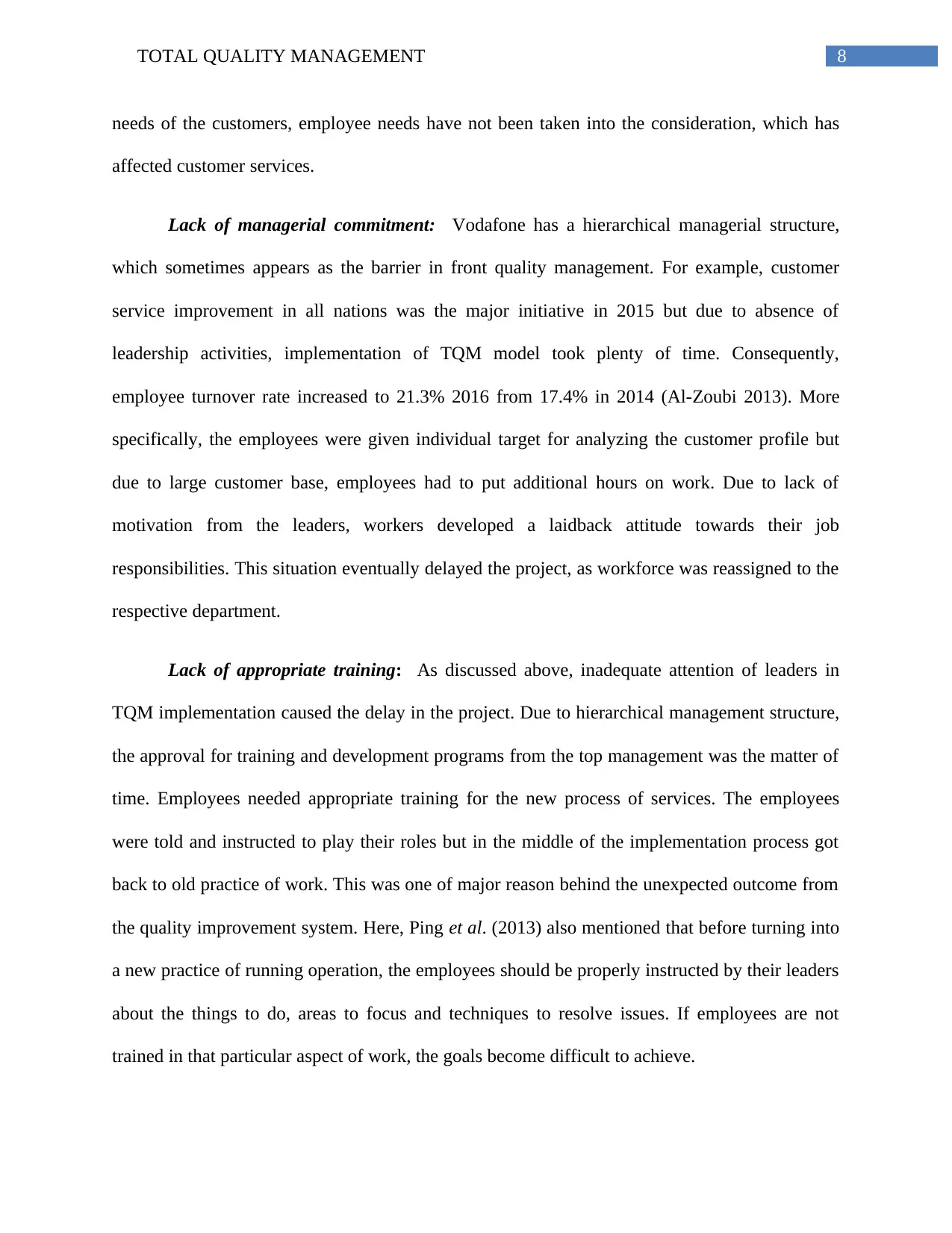
8TOTAL QUALITY MANAGEMENT
needs of the customers, employee needs have not been taken into the consideration, which has
affected customer services.
Lack of managerial commitment: Vodafone has a hierarchical managerial structure,
which sometimes appears as the barrier in front quality management. For example, customer
service improvement in all nations was the major initiative in 2015 but due to absence of
leadership activities, implementation of TQM model took plenty of time. Consequently,
employee turnover rate increased to 21.3% 2016 from 17.4% in 2014 (Al-Zoubi 2013). More
specifically, the employees were given individual target for analyzing the customer profile but
due to large customer base, employees had to put additional hours on work. Due to lack of
motivation from the leaders, workers developed a laidback attitude towards their job
responsibilities. This situation eventually delayed the project, as workforce was reassigned to the
respective department.
Lack of appropriate training: As discussed above, inadequate attention of leaders in
TQM implementation caused the delay in the project. Due to hierarchical management structure,
the approval for training and development programs from the top management was the matter of
time. Employees needed appropriate training for the new process of services. The employees
were told and instructed to play their roles but in the middle of the implementation process got
back to old practice of work. This was one of major reason behind the unexpected outcome from
the quality improvement system. Here, Ping et al. (2013) also mentioned that before turning into
a new practice of running operation, the employees should be properly instructed by their leaders
about the things to do, areas to focus and techniques to resolve issues. If employees are not
trained in that particular aspect of work, the goals become difficult to achieve.
needs of the customers, employee needs have not been taken into the consideration, which has
affected customer services.
Lack of managerial commitment: Vodafone has a hierarchical managerial structure,
which sometimes appears as the barrier in front quality management. For example, customer
service improvement in all nations was the major initiative in 2015 but due to absence of
leadership activities, implementation of TQM model took plenty of time. Consequently,
employee turnover rate increased to 21.3% 2016 from 17.4% in 2014 (Al-Zoubi 2013). More
specifically, the employees were given individual target for analyzing the customer profile but
due to large customer base, employees had to put additional hours on work. Due to lack of
motivation from the leaders, workers developed a laidback attitude towards their job
responsibilities. This situation eventually delayed the project, as workforce was reassigned to the
respective department.
Lack of appropriate training: As discussed above, inadequate attention of leaders in
TQM implementation caused the delay in the project. Due to hierarchical management structure,
the approval for training and development programs from the top management was the matter of
time. Employees needed appropriate training for the new process of services. The employees
were told and instructed to play their roles but in the middle of the implementation process got
back to old practice of work. This was one of major reason behind the unexpected outcome from
the quality improvement system. Here, Ping et al. (2013) also mentioned that before turning into
a new practice of running operation, the employees should be properly instructed by their leaders
about the things to do, areas to focus and techniques to resolve issues. If employees are not
trained in that particular aspect of work, the goals become difficult to achieve.
⊘ This is a preview!⊘
Do you want full access?
Subscribe today to unlock all pages.

Trusted by 1+ million students worldwide
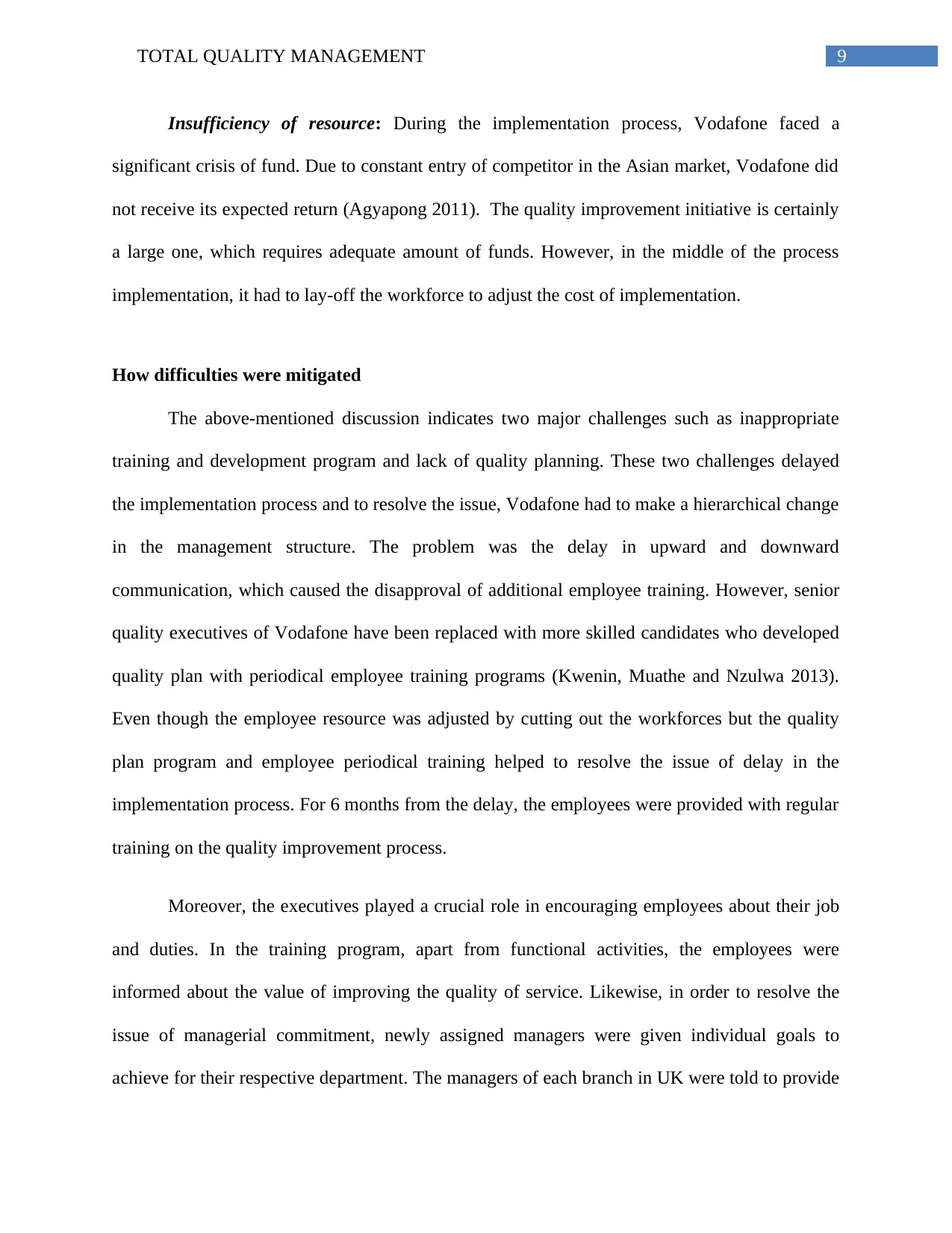
9TOTAL QUALITY MANAGEMENT
Insufficiency of resource: During the implementation process, Vodafone faced a
significant crisis of fund. Due to constant entry of competitor in the Asian market, Vodafone did
not receive its expected return (Agyapong 2011). The quality improvement initiative is certainly
a large one, which requires adequate amount of funds. However, in the middle of the process
implementation, it had to lay-off the workforce to adjust the cost of implementation.
How difficulties were mitigated
The above-mentioned discussion indicates two major challenges such as inappropriate
training and development program and lack of quality planning. These two challenges delayed
the implementation process and to resolve the issue, Vodafone had to make a hierarchical change
in the management structure. The problem was the delay in upward and downward
communication, which caused the disapproval of additional employee training. However, senior
quality executives of Vodafone have been replaced with more skilled candidates who developed
quality plan with periodical employee training programs (Kwenin, Muathe and Nzulwa 2013).
Even though the employee resource was adjusted by cutting out the workforces but the quality
plan program and employee periodical training helped to resolve the issue of delay in the
implementation process. For 6 months from the delay, the employees were provided with regular
training on the quality improvement process.
Moreover, the executives played a crucial role in encouraging employees about their job
and duties. In the training program, apart from functional activities, the employees were
informed about the value of improving the quality of service. Likewise, in order to resolve the
issue of managerial commitment, newly assigned managers were given individual goals to
achieve for their respective department. The managers of each branch in UK were told to provide
Insufficiency of resource: During the implementation process, Vodafone faced a
significant crisis of fund. Due to constant entry of competitor in the Asian market, Vodafone did
not receive its expected return (Agyapong 2011). The quality improvement initiative is certainly
a large one, which requires adequate amount of funds. However, in the middle of the process
implementation, it had to lay-off the workforce to adjust the cost of implementation.
How difficulties were mitigated
The above-mentioned discussion indicates two major challenges such as inappropriate
training and development program and lack of quality planning. These two challenges delayed
the implementation process and to resolve the issue, Vodafone had to make a hierarchical change
in the management structure. The problem was the delay in upward and downward
communication, which caused the disapproval of additional employee training. However, senior
quality executives of Vodafone have been replaced with more skilled candidates who developed
quality plan with periodical employee training programs (Kwenin, Muathe and Nzulwa 2013).
Even though the employee resource was adjusted by cutting out the workforces but the quality
plan program and employee periodical training helped to resolve the issue of delay in the
implementation process. For 6 months from the delay, the employees were provided with regular
training on the quality improvement process.
Moreover, the executives played a crucial role in encouraging employees about their job
and duties. In the training program, apart from functional activities, the employees were
informed about the value of improving the quality of service. Likewise, in order to resolve the
issue of managerial commitment, newly assigned managers were given individual goals to
achieve for their respective department. The managers of each branch in UK were told to provide
Paraphrase This Document
Need a fresh take? Get an instant paraphrase of this document with our AI Paraphraser
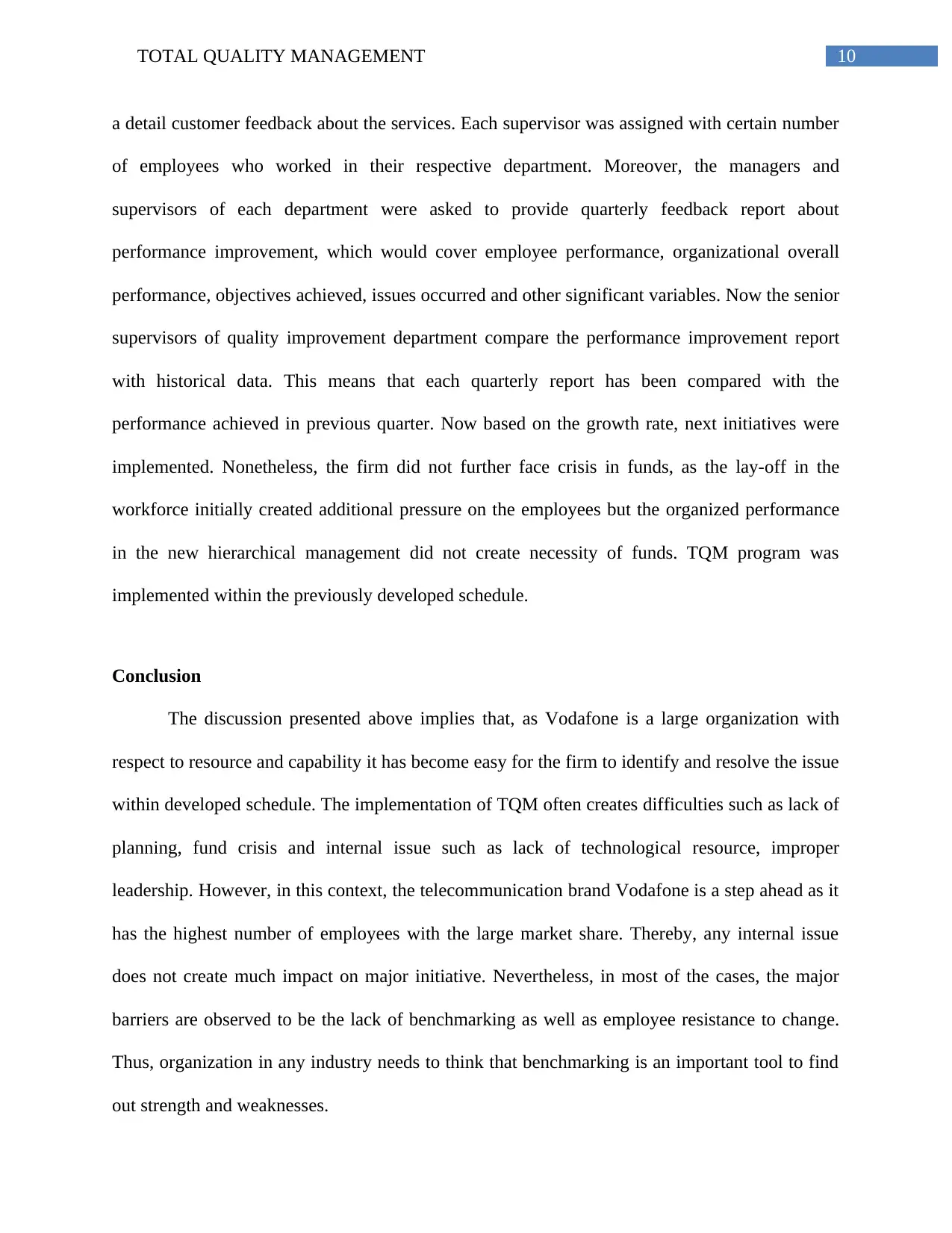
10TOTAL QUALITY MANAGEMENT
a detail customer feedback about the services. Each supervisor was assigned with certain number
of employees who worked in their respective department. Moreover, the managers and
supervisors of each department were asked to provide quarterly feedback report about
performance improvement, which would cover employee performance, organizational overall
performance, objectives achieved, issues occurred and other significant variables. Now the senior
supervisors of quality improvement department compare the performance improvement report
with historical data. This means that each quarterly report has been compared with the
performance achieved in previous quarter. Now based on the growth rate, next initiatives were
implemented. Nonetheless, the firm did not further face crisis in funds, as the lay-off in the
workforce initially created additional pressure on the employees but the organized performance
in the new hierarchical management did not create necessity of funds. TQM program was
implemented within the previously developed schedule.
Conclusion
The discussion presented above implies that, as Vodafone is a large organization with
respect to resource and capability it has become easy for the firm to identify and resolve the issue
within developed schedule. The implementation of TQM often creates difficulties such as lack of
planning, fund crisis and internal issue such as lack of technological resource, improper
leadership. However, in this context, the telecommunication brand Vodafone is a step ahead as it
has the highest number of employees with the large market share. Thereby, any internal issue
does not create much impact on major initiative. Nevertheless, in most of the cases, the major
barriers are observed to be the lack of benchmarking as well as employee resistance to change.
Thus, organization in any industry needs to think that benchmarking is an important tool to find
out strength and weaknesses.
a detail customer feedback about the services. Each supervisor was assigned with certain number
of employees who worked in their respective department. Moreover, the managers and
supervisors of each department were asked to provide quarterly feedback report about
performance improvement, which would cover employee performance, organizational overall
performance, objectives achieved, issues occurred and other significant variables. Now the senior
supervisors of quality improvement department compare the performance improvement report
with historical data. This means that each quarterly report has been compared with the
performance achieved in previous quarter. Now based on the growth rate, next initiatives were
implemented. Nonetheless, the firm did not further face crisis in funds, as the lay-off in the
workforce initially created additional pressure on the employees but the organized performance
in the new hierarchical management did not create necessity of funds. TQM program was
implemented within the previously developed schedule.
Conclusion
The discussion presented above implies that, as Vodafone is a large organization with
respect to resource and capability it has become easy for the firm to identify and resolve the issue
within developed schedule. The implementation of TQM often creates difficulties such as lack of
planning, fund crisis and internal issue such as lack of technological resource, improper
leadership. However, in this context, the telecommunication brand Vodafone is a step ahead as it
has the highest number of employees with the large market share. Thereby, any internal issue
does not create much impact on major initiative. Nevertheless, in most of the cases, the major
barriers are observed to be the lack of benchmarking as well as employee resistance to change.
Thus, organization in any industry needs to think that benchmarking is an important tool to find
out strength and weaknesses.

11TOTAL QUALITY MANAGEMENT
⊘ This is a preview!⊘
Do you want full access?
Subscribe today to unlock all pages.

Trusted by 1+ million students worldwide
1 out of 15
Related Documents
Your All-in-One AI-Powered Toolkit for Academic Success.
+13062052269
info@desklib.com
Available 24*7 on WhatsApp / Email
![[object Object]](/_next/static/media/star-bottom.7253800d.svg)
Unlock your academic potential
Copyright © 2020–2025 A2Z Services. All Rights Reserved. Developed and managed by ZUCOL.





